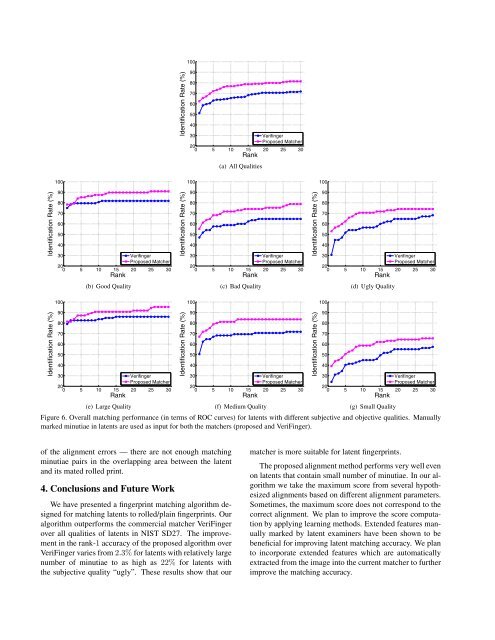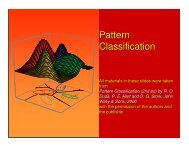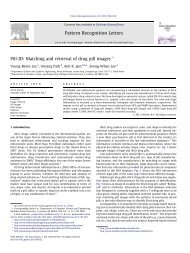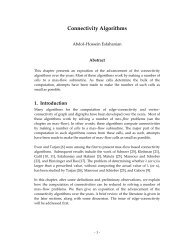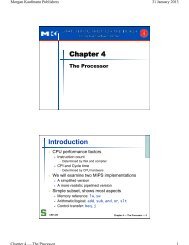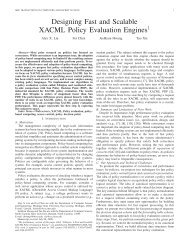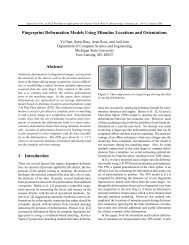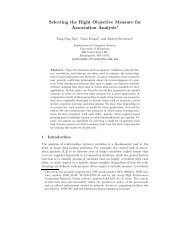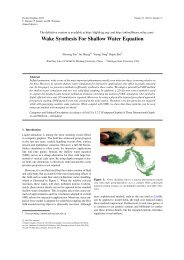Latent Fingerprint Matching using Descriptor-Based Hough Transform
Latent Fingerprint Matching using Descriptor-Based Hough Transform
Latent Fingerprint Matching using Descriptor-Based Hough Transform
You also want an ePaper? Increase the reach of your titles
YUMPU automatically turns print PDFs into web optimized ePapers that Google loves.
Identification Rate (%)<br />
Identification Rate (%)<br />
100<br />
90<br />
80<br />
70<br />
60<br />
50<br />
40<br />
30<br />
Verifinger<br />
Proposed Matcher<br />
20<br />
0 5 10 15 20 25 30<br />
100<br />
90<br />
80<br />
70<br />
60<br />
50<br />
40<br />
Rank<br />
(b) Good Quality<br />
30<br />
Verifinger<br />
Proposed Matcher<br />
20<br />
0 5 10 15 20 25 30<br />
Rank<br />
(e) Large Quality<br />
Identification Rate (%)<br />
Identification Rate (%)<br />
Identification Rate (%)<br />
100<br />
90<br />
80<br />
70<br />
60<br />
50<br />
40<br />
30<br />
Verifinger<br />
Proposed Matcher<br />
20<br />
0 5 10 15 20 25 30<br />
100<br />
90<br />
80<br />
70<br />
60<br />
50<br />
40<br />
Rank<br />
(a) All Qualities<br />
30<br />
Verifinger<br />
Proposed Matcher<br />
20<br />
0 5 10 15 20 25 30<br />
100<br />
90<br />
80<br />
70<br />
60<br />
50<br />
40<br />
Rank<br />
(c) Bad Quality<br />
30<br />
Verifinger<br />
Proposed Matcher<br />
20<br />
0 5 10 15 20 25 30<br />
Rank<br />
(f) Medium Quality<br />
Identification Rate (%)<br />
Identification Rate (%)<br />
100<br />
90<br />
80<br />
70<br />
60<br />
50<br />
40<br />
30<br />
Verifinger<br />
Proposed Matcher<br />
20<br />
0 5 10 15 20 25 30<br />
100<br />
90<br />
80<br />
70<br />
60<br />
50<br />
40<br />
Rank<br />
(d) Ugly Quality<br />
30<br />
Verifinger<br />
Proposed Matcher<br />
20<br />
0 5 10 15 20 25 30<br />
Rank<br />
(g) Small Quality<br />
Figure 6. Overall matching performance (in terms of ROC curves) for latents with different subjective and objective qualities. Manually<br />
marked minutiae in latents are used as input for both the matchers (proposed and VeriFinger).<br />
of the alignment errors — there are not enough matching<br />
minutiae pairs in the overlapping area between the latent<br />
and its mated rolled print.<br />
4. Conclusions and Future Work<br />
We have presented a fingerprint matching algorithm designed<br />
for matching latents to rolled/plain fingerprints. Our<br />
algorithm outperforms the commercial matcher VeriFinger<br />
over all qualities of latents in NIST SD27. The improvement<br />
in the rank-1 accuracy of the proposed algorithm over<br />
VeriFinger varies from 2.3% for latents with relatively large<br />
number of minutiae to as high as 22% for latents with<br />
the subjective quality “ugly”. These results show that our<br />
matcher is more suitable for latent fingerprints.<br />
The proposed alignment method performs very well even<br />
on latents that contain small number of minutiae. In our algorithm<br />
we take the maximum score from several hypothesized<br />
alignments based on different alignment parameters.<br />
Sometimes, the maximum score does not correspond to the<br />
correct alignment. We plan to improve the score computation<br />
by applying learning methods. Extended features manually<br />
marked by latent examiners have been shown to be<br />
beneficial for improving latent matching accuracy. We plan<br />
to incorporate extended features which are automatically<br />
extracted from the image into the current matcher to further<br />
improve the matching accuracy.


